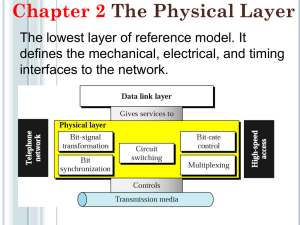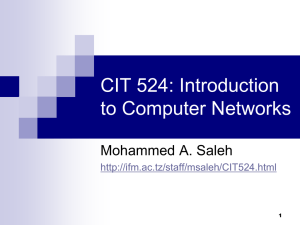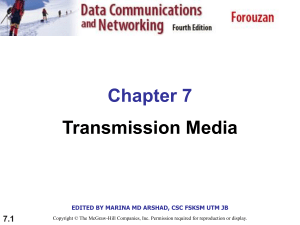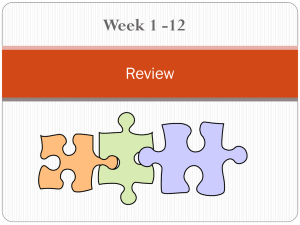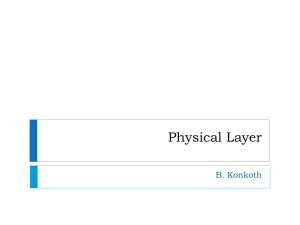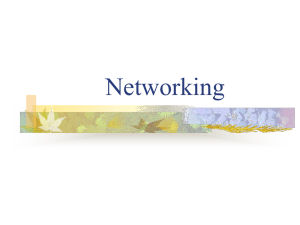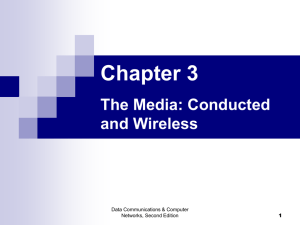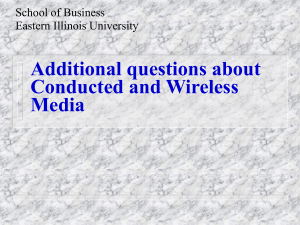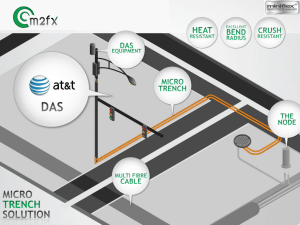Chapter 4 - HFT 3444
advertisement
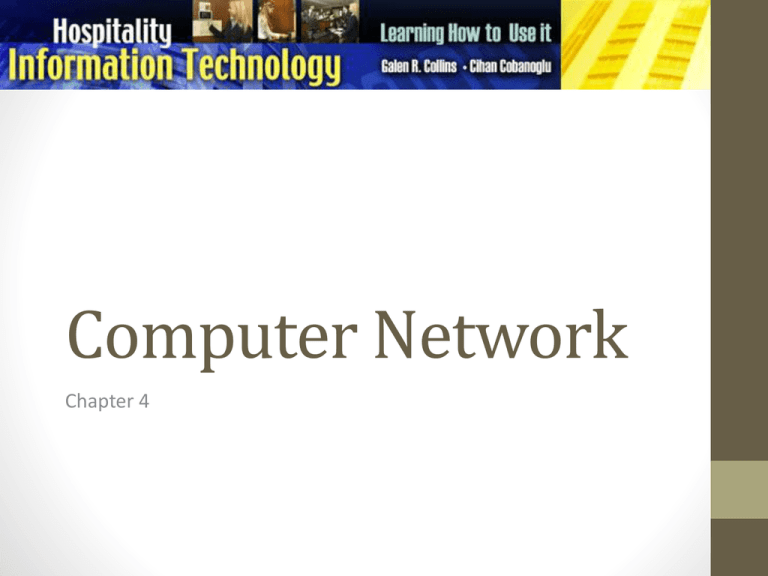
Computer Network Chapter 4 “I think there is a world of market for maybe five computers” Thomas J. Watson Chairman IBM, 1943 Why Use Networks? • Network • Group of computers and devices • Connected by transmission media • Stand-alone computer • Not connected to other computers • Uses local software and data • Advantages of networks over standalone computers • Device sharing by multiple users • Saves money and time • Central network management Types of Networks • Network models • Peer-to-Peer • Client/server Peer-to-Peer Network Figure 1-1 Resource sharing on a simple peer-to-peer network Client/Server Networks Figure 1-2 Resource sharing on a client/server network » » » » » » » » » Computers Printer Copier Fax Scanner Personal Digital Assistants Cell Phones Radios RFID (Radio Frequency ID) Networks are everywhere Introduction • Today people are often linked by wires or air (wireless) carrying voice and computer signals via the telephone system. • Data communications dominate the world. • Computer Network: The linkage of computer systems by means of communication lines or channels (e.g., fiber optic, microwave, satellite, telephone line, 802.11) Computer Network • At least two computers need to be connected •Copper •Fiber Optics •Microwaves •Infrared •Satellites Data Communications Telecommunications + Data Processing = Data Communications Data Communication • Electronic transfer of information from one computer to another. • • • • • • Data Text Pictures Graphics Video Voice Network Components (Examples) Interfaces Fibers Ethernet card Switches/routers Large router Introduction Links Wireless card Coaxial Cable Switch 1-12 Why network? • Resource sharing – Files, Applications, Printer, Fax • Communication Medium – Email, Collaboration, videoconferencing • E-business – Supply-chain, inventory, B2C Business Applications of Networks • A network with two clients and one server. Business Applications of Networks (2) • The client-server model involves requests and replies. Home Network Applications •Access to remote information •Person-to-person communication •Interactive entertainment •Electronic commerce Communication Lines/Channels • • • • Fiber optic Microwave Satellite Telephone Line etc. Impact of Data Communications 1. It enables information to be accessed and transmitted quickly. – Automatic Data Collection or Polling (i.e. Chuck E. Cheese) –menu update, get info from POS 2. 3. It allows the storing of information in a centralized database that may be shared by a few users in a small computer network or by thousands of users in a large computer network. It facilitates centralized management and decentralized operations (e.g., restaurant chain). Impact of Data Communications • It links business processes performed by independent computer systems to improve organizational efficiency and effectiveness • It links a business to its customers • Communication devices, such as cell phones, personal digital assistants, etc. Local Area Network • LAN is linkage of computers in a specific geographical area (usually within an office or building) such as in hotels, restaurants, or country clubs using transmission medium such as twisted pair wire or coaxial cable. Why Local Area Network (LAN)? • Increased processing and transfer requirements in many graphics-intensive applications now require significantly higher transfer rates (data, audio, image, video) • Decreased cost of storage space leads to program and file bloat, increased need for transfer capacity • Watch this video Basic LAN Hardware • • • • • Computers/Server(s) Resources Cables Connectors (Hubs) Network Interface Cards (Ethernet) ADVANCED • Bridges • Routers Full versus half duplex • Half duplex: communication can happen in both directions but one at a time (like walkie-talkie) • Full duplex: communication can happen in both directions at the same time (like a phone) Client • Is any network entity that can request resources from the network. • Workstations can be clients but not all clients are workstations • For example, a printer can request resources from the network, it is a client, not a workstation. Server • A computer that provides resources to the clients on the network. • Servers are typically powerful computers Switch Hub vs. Switch • Hub—sends signals to all computers connected • Switch– sends signals to intended computer(s) LANs share • Files (databases) • Resources (Printers, fax) • Programs (Fidelio, MS Office) • Working together • Communication WAN (Wide Area Network ) Communications Hardware • • • • WAN=Connection of at least two LANs Down-line processor/ Multiplexer Front-end Processor PBX(Private Branch Exchange) • Watch Video WAN Connection Types • Private Lines – Frame Relay • • • • • • Dial-Up Satellite Down Line Processor or Multiplexer Front-end Processor PBX Switchboard Shared Lines – DSL – Cable WAN in Hospitality • Global Reservation System • Central Reservation System • Property Management System LA Miami NYC Boston Hotel Marriott NYC Hotel Marriott Miami • Dial-up (max 56Kbps) •ISDN (128Kbps) •DSL (1.5Mbps) •Cable (3.5Mbps) Hotel Marriott NYC Hotel Marriott Miami •T-1 (1.5Mbps) •Frame Relay (1.5Mbps) •T-3 (43Mbps) •OC3 (155Mbps) •ATM (622Mbps) Hotel Marriott NYC •802.11b (11Mbps) •802.11g (54Mbps) •802.11a (54Mbps) •802.11n (<100Mbps) A Small LAN Wireless LAN • Advantages 1. 2. 3. • Wireless LANs are simple to set up. It literally can take 10 minutes for a simple wireless network to be setup. Wireless LANs are cheap to create. When it is not possible to wire, Wireless LANs come into rescue. Disadvantages 1. Security is the biggest down side of wireless LANs. HP Server IBM Server Network Hardware: Repeaters • Extend the length of transmission media Server Types • File Server: holds and distributes files • Print Server: handles printing jobs from clients • Proxy Server: performs a function on behalf of other computers • Application Server: hosts a network application (i.e. Marriott’s central reservation system, Marsha) • Web Server: handles web pages and other web content (i.e. Marriott.com, Hilton.com, Starwood.com) • Mail Server: hosts and delivers electronic mail. • Fax Server: sends and receives faxes electronically. • Voice over IP Server: Handles calls on Internet Protocol Physical Media • Coaxial Cable • Thinnet (BNC Connector and RG-58) • Twisted Pair Cable • Category 1 – Category 6 • RJ-11 and RJ-45 Connectors • Fiber Optic Cable Coaxial Cable • Contains a center conductor, made of copper, surrounded by a plastic jacket • Teflon type covering plenum-rated coating does not burn easily • Coax is not used in LANs today but still used widely by TV cable operators Thin Ethernet • Thinnet • 10Base-2 • Thin coaxial cable– smaller than thick coaxial cable A Stripped-back Thinnet Thinnet Connectors • With thinnet, you use BNC (BayoNet Connector) connectors to attach stations to the network. • BNC Connector locks securely with a quartertwist motion • A T-connector is used to connect backbone devices Male and Female BNC Connectors F type connector Popular with TV Cable and Cable Modems Twisted-pair cable • Consists of multiple, individually insulated wires that are twisted together in pairs • Sometimes a metallic shield is placed around pairs shielded twisted pair (STP) • Unshielded twisted pair (UTP) Why twisted? • Electromagnetic signals create interference crosstalk • Twisting the cables in pairs reduce intereference • Most common cable Twisted-pair • Cheaper • Easy to work with • Transmission rates are good Fiber Optic Cable • A glass or plastic fiber that carries light along its length. This cable is the fastest and most expensive transmission medium in the world today Advantages of Fiber Optic Cable • • • • • • • • • Superior System Performance Greatly increased bandwidth and capacity Lower signal loss Immunity to Electrical Noise Immune to noise (electromagnetic interference [EMI] and radio-frequency interference [RFI] Lower bit error rates Signal Security Difficult to tap Light weight Topology • Arrangement of workstations in a shared medium environment • Logical arrangement (data flow) • Physical arrangement (cabling scheme) Network Topologies • The manner in which workstations are connected together physically and logically is referred to as a NETWORK TOPOLOGY. • 4 Types: • • • • Bus (Video) Ring (Video) Star (Video) Hybrid BUS Topology • • • • • • Information transfer Terminators Setup is simple Expansion Repair Cost STAR Topology • Central network connector (switch) • Less than 100m. • Expansion—switchuplink • Troubleshooting • Cost—cable Ring Topology • Information flows one way • Close together • Expansion • Troubleshooting • Cost Hybrid Topology Why Hybrid (Tiered)? • • • • Reliability—less service interruption Capacity- not easily saturated Cost – low cost networks can build up Needs- not every department need the same equipment (accounting vs. graphics) Network Management • Network management is a systematic approach to planning, organizing, and controlling networks. • The five basic functions of network management are: 1. 2. 3. 4. 5. Fault management Configuration management Performance management Security Management Accounting Management Chapter 4
